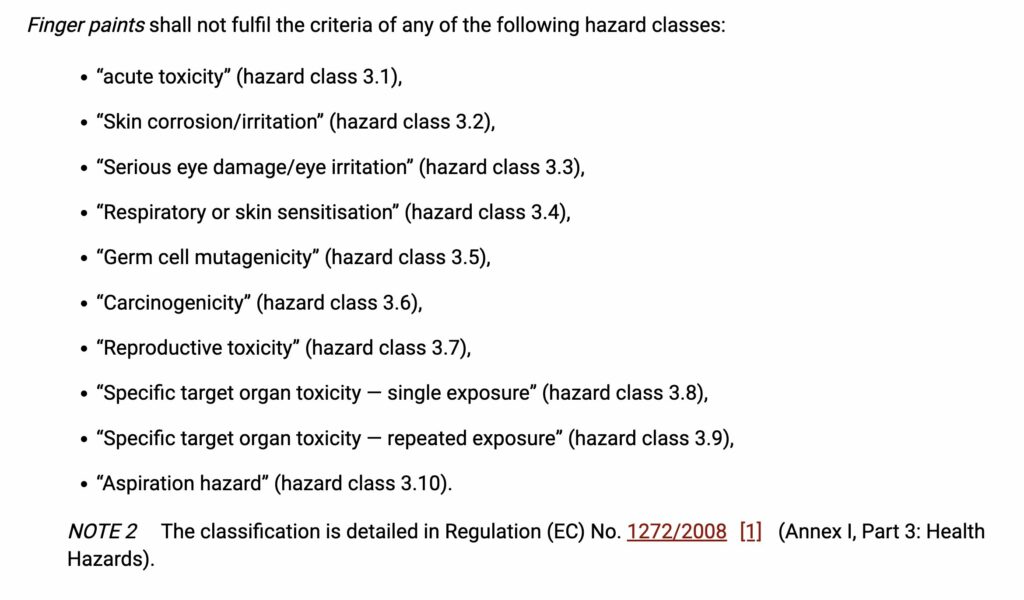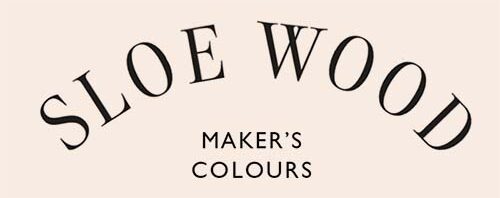#2 Safe for kids?
Including new information about your Finger Paint and Playdough
We assessed that these food colourants are NOT safe for children’s crafts. (see the reasoning in our article regarding the permeability and health risks with small particle sizes for long skin exposure)
This is not just us. Companies who make finger paints with only vegetable colours agree. As their whole premise is that synthetic food colourings are not safe for very young children for finger paint.
I know that finger paints have different standards, but haven’t looked at it in depth yet.
I found the following information – important for parents.
Finger Paint EN71-7
Finger Paint needs to meet EN71-7. (Not EN71-3)
EN71-7 specifically states that it must NOT use certain azo colourants exactly for the reasons we laid out in the article. (permeability etc)

EN71-7 includes special chemical testing required to detect particular elements of any azo colourants that might be present in finger paint.
EN71-7 states that Finger Paint should not use material linked to various health hazards including:
- Germ cell mutagenicity
- Carcinogenicity
- Reproductive toxicity
All of these risks are frequently linked to food colouring.

[Clarification]
Again, this is in context of what your safety claim is. We’re not saying finger paints using food colourings can not meet EN71-7. They will probably meet it if tested (although TL finger paints are not tested) But are they ‘safe’? That’s highly controversial.
See this EU report ‘Opinion on azo colorants in toys’ . (also consider even food colourings are linked to the similar carcinogenicity in many reports.)
When Tiny Land makes a claim that their product is ‘safe’ and ‘the safest in the market’, there are many who would disagree. Certainly we would not agree that finger paint with food colouring is ‘safe’ let alone ‘the safest’ after learning all about food colouring. We stated before in the original article. EN71 is NOT a good enough standard for many, not just us. We will never sell finger paints or kids art material with copious amount of synthetic food colourings as ‘safe’, let alone with ‘the safest’ and ‘safe to eat’ claims.
Playdough EN71-9
EN71-9 (standard for playdough) also prohibits certain aromatic amines.
Some azo colourants in food colouring, can break down into aromatic amines under certain conditions. The reasons and risks: same as above. As we mentioned in ‘Food Grade’ section, the new dangers of food colours are being discovered on an ongoing basis.
We believe food colourings (azo colourants) are, in principle, NOT a safe choice for kids’ crafts, regardless of whether they’re allowed or not.
In response to Tiny Land’s answer to our first article:
TL’s claims are that food colouring are:
Food colourings are
- Safe because it’s food-grade
- Safe because it’s pure
- Safe within limits
- Other paints are worse and TL is the safest
- Safe because it’s food-grade: Wrong
A lot of this has already been explained. - Safe because it’s pure: Wrong
It’s chemically ‘pure’ and this suggests nothing about safety.
It just means it doesn’t have additional harmful contaminants. (the minimum requirement, but not sufficient for us)
‘Pure’ food colourings can break down in the body and become harmful aromatic amines. ‘Pure’ nanoparticles are not safe. ‘Pure’ benzene, toluene, chloroform etc are not safe for the body etc etc. - Safe if used within limits: Wrong
See no.1
It has a ‘limit’ to control damage. FSA recommends manufacturers not to use any if possible and at no amount for under 3 years etc.
[Afterword]
Seeing their argument, I think we have a fundamentally different definition of what is ‘safe’ for kids from Tiny Land.
So far, Tiny Land’s argument is that it is ‘safe’ if the regulation/government permits the use and approve it. They think no warning or disclaimer is even needed if it meets the bare minimum regulatory requirement.
Our, and I believe many other company’s and parent’s, definition of ‘safe’ is not the same.
They say that what we’re saying is a slander because their product is ‘officially’ ‘safe’ and even ‘the safest’.
The ‘safest’ claim is objectively false. I can point to other safer products in the market (using natural veg/fruit colours and safe mineral colours). As for ‘safe’ – we strongly disagree and will not sell and promote these products as ‘safe’ for children’s crafts.
